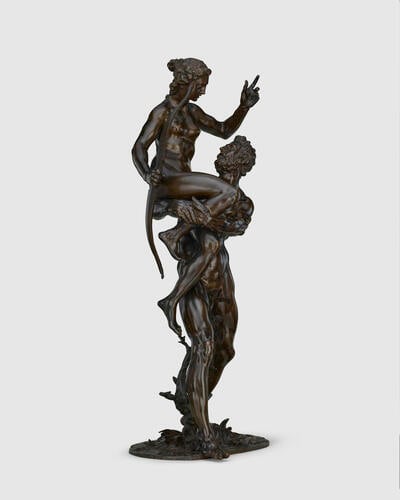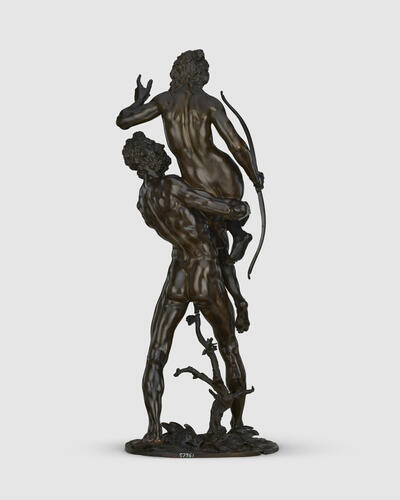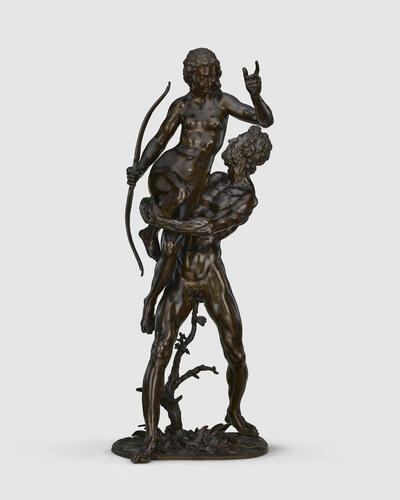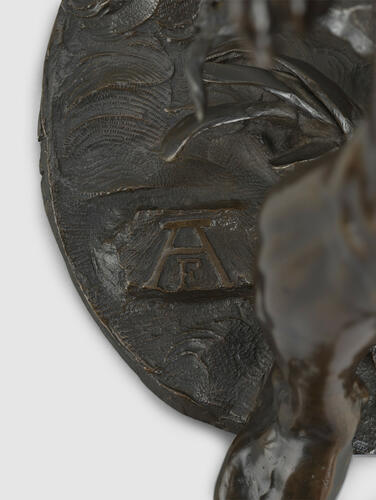-
1 of 253523 objects
Antiope and Theseus c. 1600-1
Bronze | 95.0 x 36.8 x 35.6 cm (whole object) | RCIN 57961

Adriaen de Vries (c. 1556-1626)
Antiope and Theseus c. 1600-1

Adriaen de Vries (c. 1556-1626)
Antiope and Theseus c. 1600-1




-
A bronze group of a tall nude male figure and a nude female figure, the male supported by a stunted leafy branch rising between his feet and clasping the female figure in his arms, she holds a bow in her right hand. The ovoid base is modelled with vigorous plants and a raised AF monogram in relief.
The Dutch-born sculptor Adriaen de Vries was trained in the workshop of the great Florentine master Giovanni Bologna (Giambologna; 1529-1608) and travelled between several of the major courts of Europe. His best-known works were the colossal outdoor groups and fountains in Augsburg, Prague, and Frederiksborg in Denmark. Many of his compositions share the elongated proportions and sense of upward movement that are strongly evident in this piece.
The work represents a direct challenge to the tradition of the essentially pyramidal group of three or more figures, designed for marble by Michelangelo and Giambologna, the artists with whom Adriaen de Vries was most familiar from his training, and demonstrates his delight in the medium of bronze, in which the relative mass and strength of the material enables gravity-defying compositions such as this.
From Giambologna onwards, subjects involving male figures carrying off females were regarded as particularly suitable for contrasting types of figures which could be viewed in the round. The identity of these two is by no means certain, but they are generally thought to represent Theseus, legendary King of Athens, abducting Antiope, Queen of the Amazons. Their union resulted in the birth of Hyppolytus. At various points in their history they have been interpreted as 'Diana carried off by the giant Antaeus' (a hypothesis no doubt encouraged by the elongated proportions of the male figure), and 'Achilles carrying off Briseis' (her bow, apparently, referring to her father as a priest of Apollo). The female figure clearly once held another object in her raised hand, in the palm of which is a wire loop, perhaps to attach an arrow.
A more widely known and repeated group of Hercules, Nessus and Deianira of 1603-08 is in the Louvre, Paris. There the space between the male figure's widely spaced legs is occupied by the defeated centaur, Nessus, instead of the stunted plant included here. However, the relationship between that group and this bronze is unclear. The stunted plant in this example, contrasting with the high finish of the figures, clearly played a part in the casting of this group, upside-down and in one 'pour' from the original wax model; the plant would have served as a vent to allow air to escape as the molten bronze entered the mould.
The unusual AF monogram on this bronze was also used by De Vries on his reliefs attached to the base of the Hercules fountain in the Weinmarkt at Augsburg, completed in 1602. The form of the monogram, and perhaps the unusually naturalistic plants on the base, are a tribute to Albrecht Dürer, whose work was undergoing a renaissance in South Germany around the turn of the century. Along with Nuremberg, Augsburg was one of the main centres of this renewed interest in Dürer. De Vries was active in Augsburg between 1596 and 1600, and it is possible that this bronze group was executed by De Vries at the same time as the Weinmarkt reliefs.
X-ray examination in 1998 revealed a remarkably clear picture of the process by which the sculptor constructed the wire armature beginning with fairly substantial metal rods for the legs of the male figure and adding shorter, contorted wires as the model grew in height. From his earliest works, notably the Psyche borne aloft by Putti of 1590–92 and Mercury and Psyche of 1593, De Vries showed a virtuosic interest in compositions that appeared to defy gravity, using the inherent strength of bronze. In order to underline his technical tour de force here, the sculptor playfully allowed the male figure’s feet, which would have given useful support, to protrude from the bounds of the cast base, making minimal contact with the ground. In this work as in many others, De Vries seems to set out to proclaim the power of bronze to create the illusion of lift.
Catalogue entry from Royal Treasures, A Golden Jubilee Celebration (2002) and Sculpture in the Collection of His Majesty The King (2025)Provenance
Probably acquired by George IV; Windsor Castle; Ante Throne Room; Queen’s Audience Chamber; Green Drawing Room
-
Creator(s)
(bronze maker)Acquirer(s)
-
Medium and techniques
Bronze
Measurements
95.0 x 36.8 x 35.6 cm (whole object)